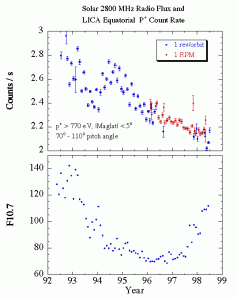Long term variation in the flux of low altitude quasi-trapped equatorial ions
The LICA ion spectrometer on SAMPEX routinely detects quasi-trapped protons near the magnetic equator. Such low-altitude, equatorial ions first were observed by Moritz (1972) and Hovestadt et al. (1972) with instruments on the Azur satellite. The ions typically have pitch angles near 90 degrees, because more field-aligned ions are rapidly lost to collisions with the neutral atmosphere. The ions originate in the ring current or inner radiation belt and charge exchange with the neutral hydrogen geocorona at high altitude. Those resulting energetic neutral atoms that travel Earthward sometimes undergo a second charge exchange with neutral O at altitudes << 250 km; these ions form the quasi-trapped ion (QTI) population. SAMPEX, at ~600km altitude, detects those ions that originate near the western edge of the South Atlantic Anomaly (SAA) and reach SAMPEX's altitude as they drift westward around the Earth on contours of constant magnetic field strength. The ions are referred to as "quasi-trapped" because they do not complete a drift orbit around the Earth, but are lost to charge-exchange when their drift paths descend to low altitude at the eastern edge of the SAA. LICA has been measuring the total flux of equatorial protons with energies > 770 keV since SAMPEX was launched in July, 1992. Figure 1 shows the change in this flux and the change in solar 2800 MHz radio flux (F10.7)over the mission. Each point in the top panel represents an average equatorial count rate. The horizontal error bars indicate the time span of each average, which was 1 month except during months when the spacecraft’s pointing mode switched between 1 revolution per orbit and 1 rpm and data taken during the different pointing modes were averaged separately. Figure 1 shows that the QTI flux does not track =4610.7. F10.7 follows the solar cycle, and is a proxy for the solar EUV flux that governs the temperature and density of the high-altitude atmosphere and ionosphere. Three factors affect the QTI flux, the density of the source ion population and geocorona at high altitude, and of the atmosphere below ~250 km. The lack of relationship between the QTI flux and F10.7 suggests that it is the density of the source ion population which is responsible for the QTI variation. =20
Contributed by Marian Greenspan, Univ of Maryland
«Return to the Results page
